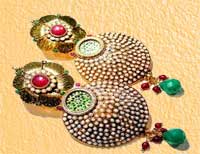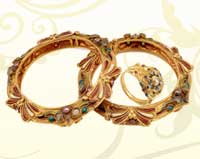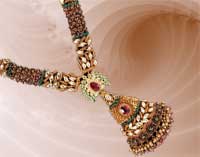ANTIQUE JEWELRY
To be acquainted with a bit about antique jewellery or antique jewellery individuals in truth has to gibe into a lot of multifarious elements. Antique jewellery or jewellery as it is meant is used to mean poles apart things. The supreme recognised explanation is some item that is in excess of 100 years old . In recent days, people use the term to mean everything in excess of 75 years old. This is a new contemporary explanation specified due to the shortage of antiques in today's open market.
As a rule lots of pieces of antique jewellery usually feature reasonable workmanship and great valued precious stones. Antique jewellery consists of numerous periods or years in their journey. Every single of them have unlike designs. Antique jewellery can be found to belong to the following time periods like: Georgian, Early Victorian, Mid-Victorian, Late Victorian, and Arts and Crafts era, Art Nouveau, Edwardian, Art Deco and Retro.

Jewelry (also signified as jewellery) are bits and pieces of any kind of material they are made of, that we use to pattern ourselves and that are prepared from any kind of material but typically made from gemstones and precious metals. Whether put, pierced from end to end, or drooped on our body, their purpose is to display or make-believe one's position. The term jewellery is the resultant from the word jewel. Advance map out hints back to the Latin word "jocale", meaning plaything.
Jewellery is one and only the oldest systems of body beautification. The chief parts of jewellery were prepared from natural resources, such as bone, animal teeth, shell, wood, and carved stone. Jewellery was so often made for general public of great importance to display their prominence and, in a lot of circumstances, they were buried with it.
Materials used in Antique Jewellery:
The commonly used materials in the Antique Jewellery are the "Metals" and "stones".
Metals can be split into:
-
Expensive metals: gold, platinum, silver.
-
Non expensive metals: iron, copper, alpaca, aluminium, etc.
-
Even up-to-the-minute metals in particular designed for space travel like titanium.
-
Or a mixture of the above mentioned metals.
Stones can be grouped as:
-
Valuable stones similar to diamonds, emeralds, sapphires and rubies.
-
Semi-valuable stones like topaz, aquamarine, tourmaline, lapis lazuli, etc.
-
As well as a lesser amount of valued stones like onyx and carnelian belonging to the family of agates.
-
Pyrite also called as foolsgold and marcasite also known as steel colored pyrite.
Additional materials that are used are:
-
Synthetic gemstones prepared with for instance the verneuil-method.
-
Strass - actually solely a strong pale glass but with an extraordinary lead content and right tranquil to facet.
-
Enamel which is nothing but melted glass.
-
Refined steel as imitation of marcasite which is low-cost itself.
-
Organic resources like ivory, amber, shells, pearls and coral.
-
Not as much of recognized materials as cows horn, elephants hair, animal skins such as leather and fish skin (e.g. Shark or sting-ray)
Antique jewellery shows the status or Identity:
-
Jewellery is so often made for a distinct occurrence or intention to display that the wearer keep an eye on a certain sport, have his place to a certain club.
-
Peasant or regional jewellery point that the wearer belongs to a particular cluster, race, and faith; with a assured public status; from a definite section; with a status such as rich, poor, uncontrolled, affianced, married, widow, etc.
-
Mourning Jewellery for several phases of the mourning era also dependent on the wearer's economic situation.
Various Designs of Antique jewellery:

It was the royal family which specially made and fixed trends for the diverse customs in making antique jewelry meekly shadowed by the upper class and bourgeoisie. The church too was a very significant representative, even though more for silversmiths than for goldsmiths. In the subsequent half of the 20th century the dwindling of the structure of the ridiculous officials becomes one of the leading causes for the loss of the "haute jouallerie".
On the other hand they hardly ever come up with remarkable jewellery as in the days of old. Fine jewellery is at present more a case of setting huge masses of diamonds in a piece rather than pointing towards for a refined and gorgeous design.
There are various antique jewellery styles and their names in the different countries over the ages.
•Pre-Victorian Jewellery: Jewelry that belonged to the Pre-victorian era. Not much details are available about the jewelry belonging to this time.
• Victorian jewellery: Objects of jewellery, which were prepared in the course of the period of influence by Queen Victoria, are in general categorized as Victorian jewellery. The portions consist of brooches and link bracelets, made of gold and festooned with enamel, and reasonably priced gemstones,at times with garnets. A proportion of coral, tortoise shell ivory and seed pearls where used. Fans, hair jewellery, and supplementary emotional kinds of jewellery were widely held.
• Art Nouveau jewellery: The art nouveau stage originated as a rebellion to the prior era of mass-produced goods and chattels. It brought out free-flowing, curving lines. Floral ornaments and botanical designs are very distinctive as well as butterflies, dragons and female appearances. The art nouveau age came to a conclusion with the outburst of world war one. Opals and moonstone were widely held and used in pendants, necklaces, and hair adornments.
• Edwardian jewellery: These accessories were general for an identical small period, for the period of the control of the King Edward the 7th. This kind of jewellery is liberally festooned with gemstones, and diamonds. The gemstones were frequently set into very skinny settings, and used in tiaras, necklaces, and earrings.
• Art Deco Jewellery: Art deco was invented in France, as a complaint to the art nouveau style. It was ignored in its premature age, but had a solid recovery in the 1960's and 1970's. Its nonconcrete designs and formal designs classify the elegance, which also structures much sharp outlines, and bold colours.
• Retro jewellery: Retro is a latest description for the era in the forties when huge scale, formalized ordered forms, drapes, bows or ribbons were all the indignation. Pink gold jewellery, fixed with colored precious stones, at times in floral forms was very common.


